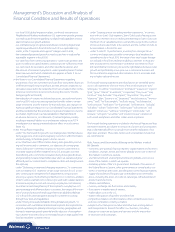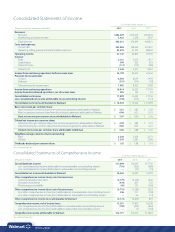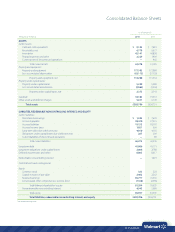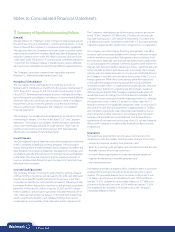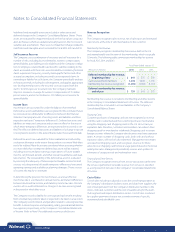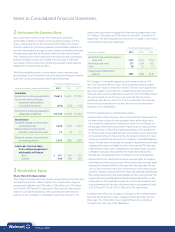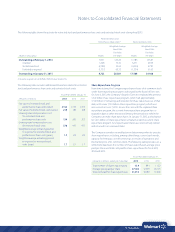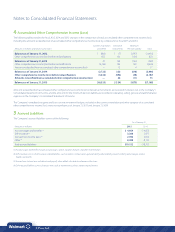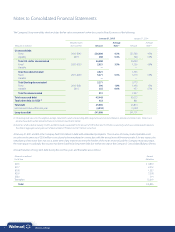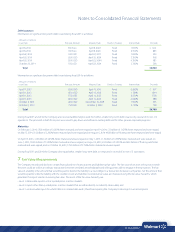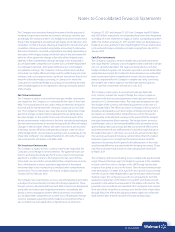Walmart 2015 Annual Report Download - page 45
Download and view the complete annual report
Please find page 45 of the 2015 Walmart annual report below. You can navigate through the pages in the report by either clicking on the pages listed below, or by using the keyword search tool below to find specific information within the annual report.
43
2015 Annual Report
Payments from Suppliers
The Company receives consideration from suppliers for various programs,
primarily volume incentives, warehouse allowances and reimbursements
for specific programs such as markdowns, margin protection, advertising
and supplier-specific fixtures. Payments from suppliers are accounted
for as a reduction of cost of sales and are recognized in the Company’s
Consolidated Statements of Income when the related inventory is sold,
except when the payment is a reimbursement of specific, incremental
and identifiable costs.
Operating, Selling, General and Administrative Expenses
Operating, selling, general and administrative expenses include all
operating costs of the Company, except cost of sales, as described above.
As a result, the majority of the cost of warehousing and occupancy for
the Walmart U.S. and Walmart International segments’ distribution
facilities is included in operating, selling, general and administrative
expenses. Because the Company does not include most of the cost of its
Walmart U.S. and Walmart International segments’ distribution facilities
in cost of sales, its gross profit and gross profit as a percentage of net
sales may not be comparable to those of other retailers that may include
all costs related to their distribution facilities in cost of sales and in the
calculation of gross profit.
Advertising Costs
Advertising costs are expensed as incurred and were $2.4 billion for both
fiscal 2015 and fiscal 2014 and $2.3 billion for fiscal 2013. Advertising costs
consist primarily of print, television and digital advertisements and are
recorded in operating, selling, general and administrative expenses in
the Company’s Consolidated Statements of Income. Reimbursements
from suppliers that are for specific, incremental and identifiable advertis-
ing costs are recognized as a reduction of advertising costs in operating,
selling, general and administrative expenses.
Leases
The Company estimates the expected term of a lease by assuming the
exercise of renewal options where an economic penalty exists that
would preclude the abandonment of the lease at the end of the initial
non-cancelable term and the exercise of such renewal is at the sole dis-
cretion of the Company. The expected term is used in the determination
of whether a store or club lease is a capital or operating lease and in the
calculation of straight-line rent expense. Additionally, the useful life of
leasehold improvements is limited by the expected lease term or the
economic life of the asset, whichever is shorter. If significant expenditures
are made for leasehold improvements late in the expected term of a
lease and renewal is reasonably assured, the useful life of the leasehold
improvement is limited to the end of the renewal period or economic
life of the asset, whichever is shorter.
Rent abatements and escalations are considered in the calculation of
minimum lease payments in the Company’s capital lease tests and in
determining straight-line rent expense for operating leases.
Pre-Opening Costs
The cost of start-up activities, including organization costs, related to new
store openings, store remodels, relocations, expansions and conversions
are expensed as incurred and included in operating, selling, general
and administrative expenses in the Company’s Consolidated Statements
of Income. Pre-opening costs totaled $317 million, $338 million and
$316 million for fiscal 2015, 2014 and 2013, respectively.
Currency Translation
The assets and liabilities of all international subsidiaries are translated
from the respective local currency to the U.S. dollar using exchange rates
at the balance sheet date. Related translation adjustments are recorded
as a component of accumulated other comprehensive income (loss). The
income statements of all international subsidiaries are translated from
the respective local currencies to the U.S. dollar using average exchange
rates for the period covered by the income statements.
Reclassications
Certain reclassifications have been made to previous fiscal year amounts
and balances to conform to the presentation in the current fiscal year.
These reclassifications did not impact consolidated operating income or
net income. Additionally, certain segment asset and expense allocations
have been reclassified among segments in the current period. See
Note 14 for further discussion of the Company’s segments.
Recent Accounting Pronouncements
In April 2014, the Financial Accounting Standards Board issued
Accounting Standards Update (“ASU”) 2014-08, Reporting Discontinued
Operations and Disclosures of Disposals of Components of an Entity, which
provides guidance for the recognition of discontinued operations,
changes the requirements for reporting discontinued operations and
requires additional disclosures about discontinued operations. This ASU
applies to prospective transactions beginning on or after December 15,
2014, with early adoption permitted. The Company adopted this ASU for
the fiscal year ended January 31, 2015 and adoption did not materially
impact the Company’s consolidated net income, financial position or
cash flows.
In May 2014, the Financial Accounting Standards Board issued ASU 2014-09,
Revenue from Contracts with Customers. This ASU is a comprehensive
new revenue recognition model that requires a company to recognize
revenue to depict the transfer of goods or services to a customer at an
amount that reflects the consideration it expects to receive in exchange
for those goods or services. This ASU is effective for annual reporting
periods beginning after December 15, 2016 and early adoption is not
permitted. Accordingly, the Company will adopt this ASU on February 1,
2017. Companies may use either a full retrospective or a modified
retrospective approach to adopt this ASU. Management is currently
evaluating this standard, including which transition approach to use,
and does not expect this ASU to materially impact the Company’s
consolidated net income, financial position or cash flows.
Notes to Consolidated Financial Statements



